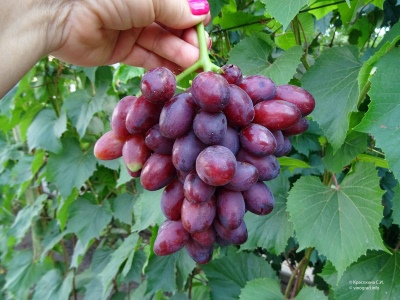
- Authors: Mincho Kondarev, Nedyalka Matevska, Bulgaria
- Appointment: dining room
- Berry color: bright red
- Taste: harmonious
- Ripening period: early
- Ripening period, days: 115-125
- Frost resistance, ° C: -18
- Bunch weight, g: 800-1000
- Yield: 130-140 c / ha
- Flower type: bisexual
In recent years, many gardeners are engaged in viticulture. Dunav fruits become an excellent table decoration. They are stored for a long time and have excellent taste.
Breeding history
Mincho Kondarev and Nedyalka Matevska were active in breeding this grape. These are breeders from Bulgaria who have managed to cross several varieties such as Balkan, Ribi Mehur and Cardinal.
Description
The variety with bisexual flowers belongs to the table. Vigorous bushes require timely pruning. In the plant, the percentage of fruiting shoots is 55-65. The fruiting factor is 1.1-1.3. On one shoot, the number of inflorescences is 1.3.
Ripening period
Dunav belongs to the early varieties in terms of ripening. The fruits are harvested in 115-125 days.
Bunches
Cylindrical bunches can reach 800-1000 grams in weight. The density of the fruits is average. Peeling is observed, but insignificant and usually when the plant does not have enough sun.
Berries
Bright red grapes have a sugar level of 160-180 g / dm³. The acidity level reaches 5-6 g / dm³.
The dense, crispy flesh is highly prized. The fruits have an elongated oval shape. The berry weight can be from 8 to 10 grams.
The tasting score is 8.2 points.
Taste
Harmonious taste is another advantage of the described variety.
Yield
The yield level is 130-140 centners per hectare. Thus, Dunav is considered a high-yielding plant.


Growing features
You can grow grapes on a wide variety of soils. However, a loamy soil with good organic matter content and good drainage is considered the most suitable for commercial grape growing.
For good vegetative growth, the soil should have a pH ranging from 6.3 to 7.3. Note that the cultivation of grapes on saline soils affects its growth.
The easiest way to propagate grapes is to grow them from deciduous cuttings. However, other methods are also used:
seeds;
layering;
planting stock;
graft.
Landing
Preparing the soil for grapes is an important task. It is desirable that the site is on a slight slope, cleared of weeds. This can be achieved by deep plowing 3-4 times.
If there is a deficiency of trace elements in the soil, then it should be additionally fertilized during the last plowing. It's a good idea to add the cake along with well-rotted manure.
For growing grapes, a distance of 3.00 x 1.50 meters, 2.50 x 1.50 meters and 2.75 x 1.50 meters is sufficient for growing more than 2500 plants per hectare of land.
For planting, dig holes measuring 90 cm x 90 cm x 90 cm and fill them with well-rotted manure along with the soil.
For good soil subsidence in the planting pits, light watering should be carried out.

Pollination
Pollination is not required.
Pruning
Pruning is carried out at the rate of 8-10 eyes per vine. The number of eyes per bush should be 35-40 pcs.

Watering
Grapes need water, so watering is done regularly at all stages of growth. Irrigation of grapes with a drip irrigation system has many advantages. Waterlogging should be avoided, as this leads to numerous diseases.


Top dressing
When growing grapes, nitrogen, phosphorus and potassium must be added annually. Biofertilizers and liquid pesticides can help improve the quality of the grapes.
Spraying with humic acid in a sugar solution is useful.
Frost resistance and the need for shelter
The frost resistance of this variety is low, only -18 degrees Celsius. Shelter for the winter is a must. In this case, the vine is first removed from the trellises, then covered with material or spruce branches.

Diseases and pests
Insects can attack the vineyard, so preventive treatment with insecticides is carried out twice. Fungicides help with powdery mildew, mold and rot.

If a grape is exposed to any disease or insect, this always affects its appearance.
Storage
The Danube is perfectly transported and keeps its presentation. Can be stored in refrigerators for a long time.











































































